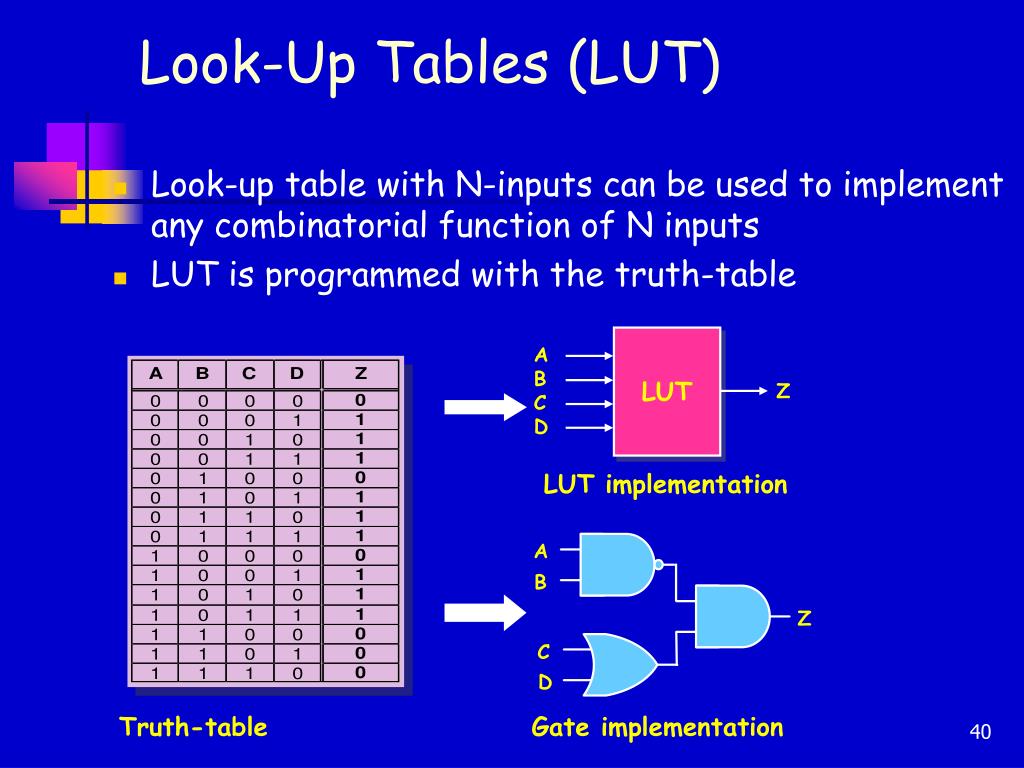
Now that you are more familiar with these wonderfully versatile components, it is time to discuss the other most important element inside of an FPGA: A single FPGA has thousands of these components. LUTs are one of the two most fundamental components in an FPGA. If you need to make a more complicated expression, you can just use more Look-Up Tables. 3-Input LUTs were the norm not too long ago, but today 4-Input and even 5-Input LUTs are common. LUTs can come in different sizes depending on the FPGA that you are using, but they all behave the same way. I will say that again a different way: One 3-Input LUT can make any Boolean algebra equation you can think of using 3 input signals. As you might expect, all possible combinations of boolean expressions need to be able to be programmed into the Look-Up Table. The LUT is programmed by the Digital Designer to perform a Boolean algebra equation like the two that we saw above. Instead FPGAs use Look-Up Tables or LUTs. Note that the parenthesis indicate that the operation C AND NOT B occurs prior to the OR operation.Īs was mentioned in the beginning of this article, discrete logic gates do not actually exist inside of an FPGA. Here is the equation we are going to create a truth table for: Q = A + (C*B’). Let’s now look at one more example with three inputs. Mathematically this can be represented by 2^(# of inputs). So for one input there are 2 output possibilities, for 2 inputs there are 4 output possibilities, for 3 inputs 8 output possibilities, etc. Each input increases the number of possible outputs by a factor of 2. "filename" and "filenamelinear" parameters that select where the output files will be saved on your disk.The truth table in the above example has two inputs (A and B), which means that there are four possible output possibilities. Other than the "lut" matrix, the only thing you need to change is the While the brightest voxels will appear white. (20% red, 0% blue and 0% green), while it will appear violet in the middle range (50% red and 50% blue),

My program offers two ways to combine the bias and gain settings - you can apply them independently (as shown in the main figure), or you can click the 'Mix Gain/Bias' checkbox to make these values interact. When you restart these programs, they will automatically detect the look up tables. To use a LUT with MRIcron, copy the file to the 'LUT' folder that exists in the same directory as MRIcron. To use a LUT with MRIcro, place the *.lut in the same folder as mricro.exe. Once you are happy with the resulting LUT, you can press the 'Save' button to create a *.lut file. The left set of sliders adjusts the bias, while the right set adjusts the gain. It interactively displays the levels of these three colors as well as displaying the resulting LUT applied to a MRI scan. To allow you to independently control the levels of red, green and blue in your LUT. If you want more flexibility (at the expense of ease) you should try some of the plugins available for Image that can create LUTs.Ĭhristophe Schlick's Fast Alternatives to Perlin's Bias and Gain Functions
#LOOK UP TABLE LUT SOFTWARE#
My software allows you to easily create LUTs, but the LUTs it creates are contstrained (the darkest index is always black and the brightest is always white, with typically smooth transitions in between).


The resulting lookup tables can be used with This format uses 768 bytes of disk space, with the first 256 bytes storing red data, followed by 256 bytes storing the green indexes and ending with the 256 blue indexes. This format describes 256 brightness values, with each intensity mapped using 8-bytes each of red, green and blue data. This software allows you to create LUT files in ImageJ format. Alternatively, you can often detect more subtle differences by using a lookup table that shows differing intensities using both brightness and color changes. Color lookup tables (LUTs) are used to display different image brightnesses, for example to view an X-ray of the arm, you might want to use a simple grayscale that shows air as black, bone as white and soft tissue as a gray.
#LOOK UP TABLE LUT DOWNLOAD#
Click here to download my simple LUTmaker software for creating ImageJ format color look-up tables (only available for the Windows operating system).


 0 kommentar(er)
0 kommentar(er)
